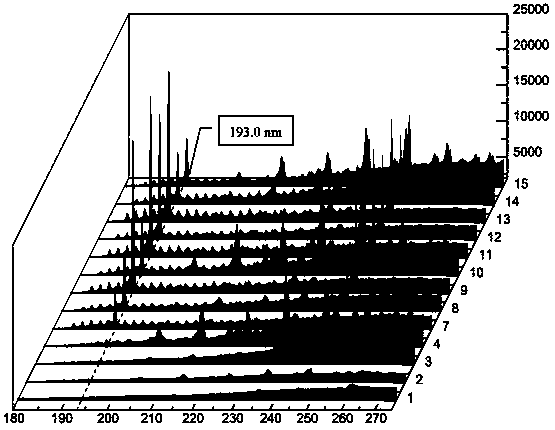A gas chromatographic detection method for the determination of carbon-containing compounds based on carbon atomic emission spectroscopy
A technique of emission spectroscopy and gas chromatography, which is applied in the field of gas chromatography detection of carbon-containing compounds based on carbon atomic emission spectroscopy, and achieves the effects of wide measurement range, enhanced sensitivity and low consumption.
- Summary
- Abstract
- Description
- Claims
- Application Information
AI Technical Summary
Problems solved by technology
Method used
Image
Examples
Embodiment 1
[0025] In this embodiment, various common volatile organic and inorganic carbon-containing compound samples are selected, and the characteristic atomic emission line of carbon element at 193.0nm produced after DBD is detected, and the carbon-containing compound is mixed with ammonia, water, hydrogen peroxide and other non-carbon-containing compounds. Compound samples are compared to confirm the detection ability of the present invention for carbon-containing compounds. The specific operation steps are: ⑴The sample enters from the gas chromatograph inlet, and enters the DBD device from the discharge gas inlet after separation; ⑵The voltage of the internal and external electrodes of the DBD device is controlled at 2.95kV; ⑶The discharge gas argon passes through the discharge gas port to 400mL min -1Enter; ⑷By controlling the voltage of the electric heating wire, the temperature of the DBD device is controlled to 300°C; ⑸After the sample enters the heated DBD device, it is atomiz...
Embodiment 2
[0027] This example examines the influence of the internal and external electrode voltages on the detection sensitivity of carbon-containing compounds in a DBD device. Referring to the operation steps of Example 1, taking formaldehyde, ethyl acetate, methanol, ethanol, n-propanol, n-butanol and n-pentanol as test objects, the test range of the inner and outer electrode voltages is 1.84-3.25kV. The experimental result of this embodiment sees attached image 3 , thus confirming that the optimum excitation voltage of the present invention is 2.54-3.25kV.
Embodiment 3
[0029] In this embodiment, the effect of the argon flow rate of the discharge gas in the DBD device on the detection sensitivity of carbon-containing compounds is investigated. With reference to the operation steps of Example 1, formaldehyde, ethyl acetate, methanol, ethanol, n-propanol, n-butanol and n-pentanol are used as test objects, and the test range of argon flow rate is 300-900mL min -1 . The experimental result of this embodiment sees attached Figure 4 , thus confirming that the optimum argon flow rate of the present invention is 300~600mL min -1 .
PUM
 Login to View More
Login to View More Abstract
Description
Claims
Application Information
 Login to View More
Login to View More - R&D
- Intellectual Property
- Life Sciences
- Materials
- Tech Scout
- Unparalleled Data Quality
- Higher Quality Content
- 60% Fewer Hallucinations
Browse by: Latest US Patents, China's latest patents, Technical Efficacy Thesaurus, Application Domain, Technology Topic, Popular Technical Reports.
© 2025 PatSnap. All rights reserved.Legal|Privacy policy|Modern Slavery Act Transparency Statement|Sitemap|About US| Contact US: help@patsnap.com



